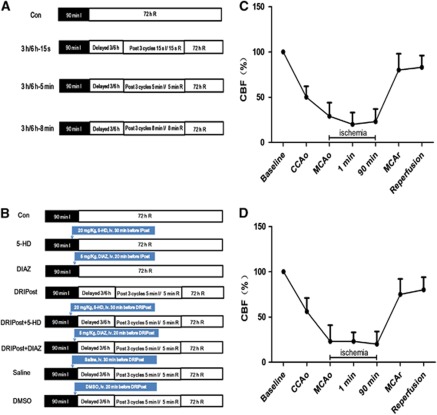Figure 1.
Schematic of the design and changes in cerebral blood flow (CBF) in animals for part 1 and part 2 of the experiment. All animals underwent 90 minutes of ischemia (dark bar) and 72 hours of reperfusion (open bar) (n=8 for each). (A) In part 1, rats were subjected to delayed remote ischemic postconditioning (DRIPost) at 3 or 6 hours after reperfusion, and the DRIPost protocol was three cycles of bilateral femoral artery occlusion 15 seconds/5 minutes/8 minutes ischemia (I)/15 seconds/5 minutes/8 minutes reperfusion (R). (B) In part 2, except for delayed 6 hours/5 minutes DRIPost, the KATP channel blocker 5-hydroxydecanote (5-HD) or opener diazoxide (DIAZ), as well as the vehicle physiologic saline and dimethyl sulfoxide (DMSO), was injected through the caudal vein 20 minutes (for 5-HD and saline) or 30 minutes (for DIAZ and DMSO) before DRIPost to investigate the role of KATP channels in DRIPost-induced neuroprotection against focal cerebral ischemia–reperfusion injury. (C, D) Changes in CBF in animals subjected to 90 minutes ischemia followed by 72 hours reperfusion. Right common carotid artery (CCA) occlusion reduced CBF to ∼50% of the baseline, and additional middle cerebral artery (MCA) occlusion further decreased CBF to ∼20%. CCAo, CCA occlusion; MCAo, MCA occlusion; MCAr, MCA release.

